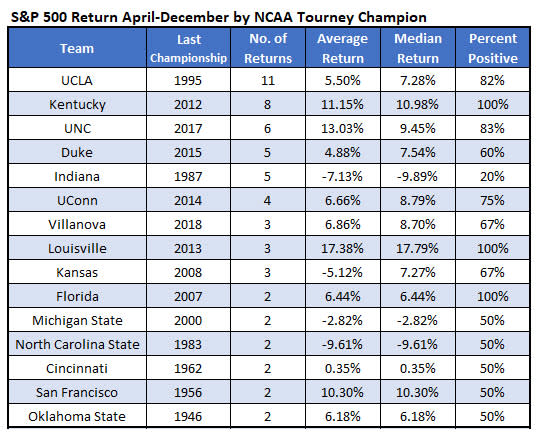March Madness Indicator: Stocks Rally When This Team Cuts Down the Nets
March Madness is once again upon us, with Round 1 games kicking off this week. While many of us here at Schaeffer's are rooting for our hometown Cincinnati Bearcats, history indicates stock market bulls may want to root for a 2 seed this year, if past is prologue.
Below are S&P 500 Index (SPX) returns from April through December, depending on the winning men's NCAA conference, courtesy of Schaeffer's Senior Quantitative Analyst Rocky White. Only conferences with at least two championships are shown.

The ACC leads all conferences in number of tourney wins at 17, the last coming courtesy of North Carolina in 2017. In years when an ACC team wins the dance, the SPX has generated a rest-of-year gain of 9.8%, and was higher 76% of the time. There are seven ACC teams in the tourney this year, three of which are No. 1 seeds: Duke, Virginia, and North Carolina.
The stat that really stood out, though, was the SPX's returns after an SEC win. There have been 11 SEC championships, the last coming in 2012, courtesy of the Kentucky Wildcats. After an SEC win, the S&P was higher from April through December 100% of the time, with an average gain of 9.56%. The SEC has seven teams in the dance this year, led by No. 2 Kentucky and No. 3 seed LSU.
The Big Ten leads all conferences this year with eight teams in the tournament, led by No. 2 seeds Michigan and Michigan State. However, there have been 11 Big Ten champions in NCAA history, and the S&P averaged a loss of 4.76% in those years, and was higher at year-end just 36% of the time.
So, which team should Wall Street bulls cheer on this year? Below are SPX returns from April through December, depending on who cuts down the nets at the end of the championship game. Only teams with at least two titles are shown.

UCLA has the most trophies, but hasn't won the championship in more than 20 years. Meanwhile, Kentucky has won eight times, the last in 2012. After these wins, the SPX was higher 100% of the time at year-end, with an average gain of 11.15%.
If you can't stomach rooting for the Wildcats, you might want to jump on the UNC bandwagon. The Tar Heels have won six times -- last in 2017 -- and the SPX averaged an April-December rally of 13.03% afterwards, and was positive at year-end 83% of the time.
In conclusion, as with the Super Bowl indicator, the results above are simply due to randomness and should be taken with a grain of salt. Instead, stock and options traders should base their positions on our Expectational Analysis methodology, which takes into account fundamental, technical, and sentiment indicators.

